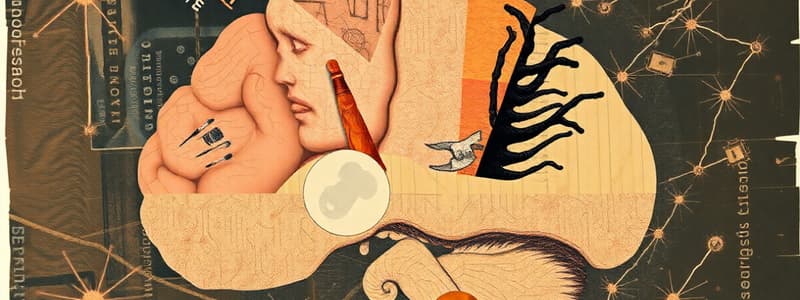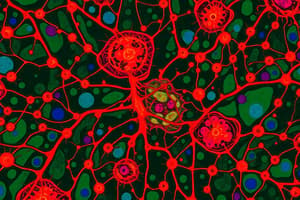Podcast
Questions and Answers
What is the primary function of astrocytes in the central nervous system?
What is the primary function of astrocytes in the central nervous system?
- Myelination of axons
- Secretion of cerebrospinal fluid
- Formation of the blood-brain barrier (correct)
- Phagocytosis of damaged cells
Which type of neuroglia is responsible for the myelination of nerve fibers in the peripheral nervous system?
Which type of neuroglia is responsible for the myelination of nerve fibers in the peripheral nervous system?
- Ependymal cells
- Oligodendrocytes
- Microglia
- Schwann cells (correct)
How do microglia function in the nervous system?
How do microglia function in the nervous system?
- Scanning for damaged cells and microorganisms (correct)
- Regenerating damaged neurons
- Secreting cerebrospinal fluid
- Providing structural support to neurons
What characterizes protoplasmic astrocytes compared to fibrous astrocytes?
What characterizes protoplasmic astrocytes compared to fibrous astrocytes?
What type of cells line the central canal of the spinal cord and brain ventricles?
What type of cells line the central canal of the spinal cord and brain ventricles?
Which of the following statements about satellite cells is accurate?
Which of the following statements about satellite cells is accurate?
Which neuroglial cell can myelinate multiple axon segments in the central nervous system?
Which neuroglial cell can myelinate multiple axon segments in the central nervous system?
What distinguishes Schwann cells from oligodendrocytes?
What distinguishes Schwann cells from oligodendrocytes?
What is a distinguishing feature of fibrous astrocytes compared to protoplasmic astrocytes?
What is a distinguishing feature of fibrous astrocytes compared to protoplasmic astrocytes?
Which neuroglial cell type is primarily responsible for the formation of the blood-brain barrier?
Which neuroglial cell type is primarily responsible for the formation of the blood-brain barrier?
What function distinguishes Schwann cells from oligodendrocytes in terms of myelination?
What function distinguishes Schwann cells from oligodendrocytes in terms of myelination?
What role do microglia play in the nervous system?
What role do microglia play in the nervous system?
Which characteristic is true about ependymal cells?
Which characteristic is true about ependymal cells?
Which of the following statements best describes satellite cells?
Which of the following statements best describes satellite cells?
Which neuroglial cell is known for its ability to migrate throughout nervous tissue?
Which neuroglial cell is known for its ability to migrate throughout nervous tissue?
Which of the following correctly matches neuroglial cells with their location?
Which of the following correctly matches neuroglial cells with their location?
Flashcards
Astrocytes in CNS
Astrocytes in CNS
Star-shaped glial cells with processes, that support neurons and form the blood-brain barrier.
Oligodendrocytes in CNS
Oligodendrocytes in CNS
Glial cells that myelinate CNS nerve fibers (axons). One cell can myelinate a short segment of several axons.
Microglia in CNS
Microglia in CNS
Small glial cells that migrate and are phagocytic, removing damaged cells and microorganisms.
Ependymal cells in CNS
Ependymal cells in CNS
Signup and view all the flashcards
Schwann cells in PNS
Schwann cells in PNS
Signup and view all the flashcards
Satellite cells in PNS
Satellite cells in PNS
Signup and view all the flashcards
Blood-brain barrier
Blood-brain barrier
Signup and view all the flashcards
Cerebrospinal fluid (CSF)
Cerebrospinal fluid (CSF)
Signup and view all the flashcards
Neuroglia
Neuroglia
Signup and view all the flashcards
Types of neuroglia
Types of neuroglia
Signup and view all the flashcards
Astrocytes
Astrocytes
Signup and view all the flashcards
Oligodendrocytes
Oligodendrocytes
Signup and view all the flashcards
Microglia
Microglia
Signup and view all the flashcards
Ependymal cells
Ependymal cells
Signup and view all the flashcards
Schwann cells
Schwann cells
Signup and view all the flashcards
Satellite cells
Satellite cells
Signup and view all the flashcards
Study Notes
Nervous Tissue
- Nervous tissue is composed of neurons and neuroglia
- Neuroglia are significantly more abundant than neurons (approximately 10x more)
- Neuroglia are categorized by their location: central nervous system (CNS) and peripheral nervous system (PNS)
Neuroglia Classification
- Central Nervous System (CNS): Astrocytes, Oligodendrocytes, Microglia, Ependymal cells
- Peripheral Nervous System (PNS): Schwann cells, Satellite cells
Astrocytes
- Star-shaped glial cells with radiating processes
- Two types: Fibrous (few, long, straight processes) and Protoplasmic (many, short, branching processes)
- Function:
- Contribute to the blood-brain barrier
- Provide structural support
- Regulate ion, nutrient, and dissolved gas concentrations
- Absorb and recycle neurotransmitters
- Form scar tissue after injury
Oligodendrocytes
- Glial cells responsible for myelination in the CNS
- Single oligodendrocyte can myelinate multiple nerve fibers (axons)
Microglia
- Small, glial cells with short, irregular processes
- Abundant as neurons
- Mobile, migrating cells
- Phagocytic cells, removing damaged cells and microorganisms in the nervous tissue
- Remove cell debris, wastes, and pathogens
Ependymal Cells
- Cuboidal-shaped cells lining the central canal of the spinal cord and brain ventricles
- Secrete cerebrospinal fluid (CSF)
- Assist in producing, circulating, and monitoring of cerebrospinal fluid
Schwann Cells
- Glial cells responsible for myelination in the PNS
- Unlike oligodendrocytes, one Schwann cell myelinates a single axon segment
- Participate in repair process after injury
Satellite Cells
- Capsular cells surrounding neuron cell bodies in ganglia
- Provide supportive, nourishing, insulating, and regulating functions for the neurons in their microenvironment
- Surround neuron cell bodies in ganglia, regulating O2, CO2, nutrient, and neurotransmitter levels around neurons in ganglia
Studying That Suits You
Use AI to generate personalized quizzes and flashcards to suit your learning preferences.




